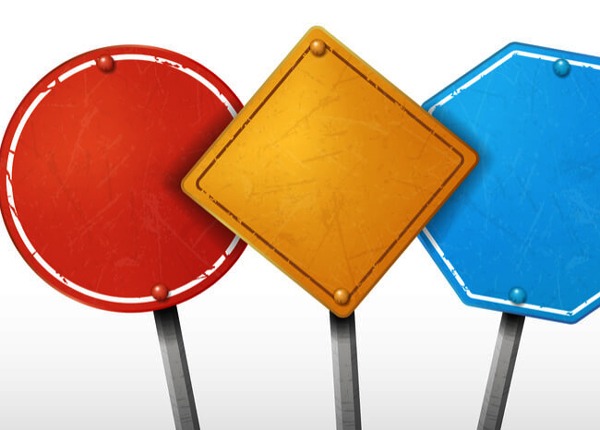
Recognizing Road Signs by Shape and Color: Advanced Driving Techniques
Updated Oct. 20, 2020A significant number of road signs have been discussed in this section. There are a great many more that have not been addressed, which you may encounter while driving in the future. Fortunately, you do not need to memorize every individual road sign to stay safe and obey the rules of the road.
Based on its color and shape, the general meaning of a road sign can be determined without too much thought. Road signs were purposefully designed this way, as high-speed roads and distracting environments do not afford drivers much time to consider the meaning of a single sign.
The main classes of road signs are regulatory signs, warning signs, construction zone signs and guide signs. Often, there are further sub-categories of signs within these classes. Signs within a certain class or sub-category usually share the same color and shape – though there are some exceptions.
Road signs with unique designs
If a road sign is a different color or shape to others in its class, it is often because that sign is particularly important and must be instantly recognizable to drivers. STOP and YIELD signs are a good example of this phenomenon. They are technically regulatory signs, though they do not fit in with the standard color and shape used for those signs. STOP and YIELD signs have unique designs, as road user safety depends on all drivers interpreting them correctly.
Road sign shapes
These are the shapes you must remember to identify road sign meanings:
- 1

Octagon.
STOP signs are the only octagon-shaped road signs. Every stop sign is a red octagon. They may or may not feature the word “STOP”. - 2

Triangle.
YIELD signs are red and white inverted triangles (the tip of the triangle points downward). No other road signs are triangles. - 3

Rectangle.
This shape is used for regulatory signs and guide signs. Vertical rectangles usually indicate regulatory signs, whereas horizontal rectangles are usually guide signs. - 4

Diamond.
This shape is reserved exclusively for warning signs, including temporary work zone signs. A diamond-shaped sign means you must reduce speed and proceed with caution. - 5

Pentagon.
These signs are used to mark school zones. They warn drivers to reduce speed and look out for children near the roadway. - 6

Circle.
Yellow and black circular signs or white circular signs printed with an “X” warn drivers that they are approaching a railway crossing. - 7

Pennant.
These signs look somewhat like elongated, triangular flags. They mark the start of a “no passing zone”.
Road sign colors
Road sign colors also tell drivers a great deal about the meaning of the sign, as per this list:
- 1

Red.
All red road signs are important regulatory signs. They issue instructions which drivers must obey, for instance: STOP, YIELD, DO NOT ENTER and WRONG WAY. - 2

Red and white.
Red and white signs signify that motorists must prepare to stop. The only road signs that use red and white without any other colors are STOP signs, YIELD signs, DO NOT ENTER signs and WRONG WAY signs. - 3

Black and white.
These are usually general regulatory signs, which prohibit certain actions, give instructions or state the road rules in that area. Certain route markers are also black and white. - 4

Yellow.
Most warning signs are colored yellow. They warn drivers about adverse conditions and hazards on the roadway. - 5

Orange.
Warning signs used around construction or maintenance sites are all orange. - 6

Blue.
Blue guide signs tell drivers about nearby or upcoming service facilities. - 7

Green.
Green guide signs tell drivers about location, often including directions and distances to upcoming destinations. - 8

Brown.
Brown guide signs mark recreational facilities, parks, historical sites and other attractions. - 9

Pink.
Coral-colored signs are used around incident sites. These temporary signs are used to direct motorists around hazardous spills, flooded roads, fallen trees, mudslides and car accidents.
Learning to recognize road signs
Road signs are guaranteed to be addressed as part of your written learners permit test. We recommend reading back through this section of our course as you study. Learning the common shape and color themes used for different types of road sign – as discussed on this page – is particularly important, as it will help you to identify any unusual road signs that appear on the exam.
Here is a brief summary of the colors and shapes you can expect to see, based on road sign type (more detailed information can be found in former modules):
- 1

Regulatory Signs (enforce road rules).
Typically black and white rectangles. Some important ones are red and white with unique shapes. - 2

Warning Signs (tell drivers to proceed with caution).
Yellow or orange, with black text. Usually diamond-shaped. Some worksite warning signs may be rectangular. - 3

Guide Signs (provide information about location).
Most are blue, green or brown rectangles. Route markers vary in color but are often blue or black and white. - 4

Railroad Crossing Signs (warn drivers about railway tracks).
Black and white. Usually two crossed rectangles or an “X” symbol in a circle.
When you begin learning to drive on the open road, your familiarity and confidence with road signs will quickly progress. As you learn, remember to keep your speed to a minimum and pay attention to all signs posted on and around the roadway.




